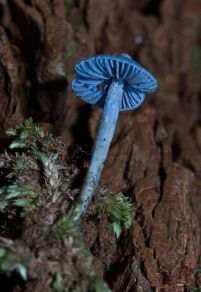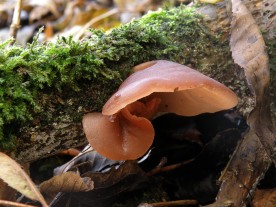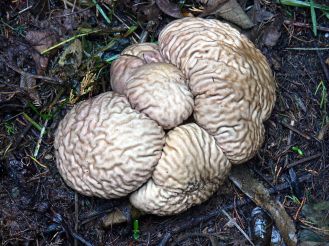The Forgotten Kingdom
We often think about Plants and Fungi together, but in truth Fungi are more closely related to humans than plants. They belong to their own separate kingdom containing millions of species, vastly outnumbering plants. Not only that, but the part of the fungi we are most familiar with – the toadstool or mushroom – is just the tip of the iceberg. Most of the fungi lies below the soil, a massive network of thread-like cells. The mushroom is simply a reproductive organ, like the flower of a plant, it bursts forth to spread its spores and then dies away again.
But this forgotten kingdom does have an important and crucial link with plants. 95% of all plant families form mutualistic relationships with fungi in the soil. Plants supply the fungi with food from the sun and in return fungi supply extra water and nutrients. Without this relationship, plants might never have been able to colonise the land at all.
In New Zealand, around 7,500 species have been described but many more wait to be discovered. While fungi use is not particularly common in New Zealand, fungi have served an important role in our history and culture. The following list contains some of the more common fungi in New Zealand that have been used by humans for food, medicine or recreation.
Basket Fungus – Ileodictyon cibarium

This strange, foul smelling fungus was known to Māori as Tūtae kēhua – ghost dung. It certainly looks like the kind of thing left behind by ghosts, and often emerges after thunderstorms. Māori would eat the thick gooey shell before the basket bursts out and develops a layer of stinky slime. It could be roasted in the ashes of a fire, or cooked in hāngī.
Werewerekōkako – Entoloma hochstetteri

The most distinctive fungi in the country, Werewerekōkako immediately stands out on the forest floor with a bright turquoise blue. The Māori name derives from this blue colour, which resembles the wattles of Kōkako. It has the distinction of being the only fungi in the world to feature on a bank note, being found on the reverse of the New Zealand 50$ note. It is not known to be toxic, although other members of this genus are.
Wood Ear Fungus – Auricularia polytricha

Wood ear was eaten by Māori when nothing better could be found to eat – and even then was stewed with other food to hide the taste. However it is a popular food in China where it is also used medicinally. In the late 1800s New Zealand had a thriving trade exporting it from Taranaki to China. Its other name “Jews Ear Fungus” is a reference to Judas Iscariot, who is reputed to have hanged himself on an elder tree after the betrayal of Jesus Christ.
Vegetable Caterpillar – Cordyceps robertsii

The vegetable caterpillar belong to a family of fungi that are parasites on insect hosts. The fungi grows inside caterpillars, consuming the tissue of their host before bursting forth to release its spores. Māori used Vegetable caterpillar to treat asthma. When burnt, it produces a dark black soot, which was mixed with mahoe berries and bird fat to produce ink for Tā moko.
Heart Rot Fungus – Agrocybe parasitica

Heart rot fungus was used by Māori to treat fever, and was also given to expectant mothers before birth, although the purpose of this remains unclear. It was also used as an antidote to poisoning by toxic plants such as Karaka and Tutu.
Putawa – Laetiporus portentosus

Putawa was used by Māori as tinder for lighting fires, and could be useful for carrying fires between locations. It was also used medicinally as a wound protector, and to help ease a difficult childbirth.
Puffball – Calvatia spp.

These brain-like fungi were eaten by Māori when young. They could also have a range of medicinal uses, the spores were applied to heal burns, it could be used to stop bleeding, and taken as an anaesthetic.
Magic Mushrooms – Psilocybe spp.

Yes, in case you were wondering – New Zealand does contain its share of Psilocybe or “Magic” mushrooms. If consumed, these mushrooms produce intense, hallucinatory experiences. The cap and stalk of the mushrooms turns blue when handled. It is a criminal offence to harvest these mushrooms in New Zealand.
Fly Agaric – Amanita muscaria

The quintessential toadstool from fairy tales and children’s books – Fly Agaric produces hallucinations if eaten and can send the victim into a deep coma-like sleep. To date there have been no fatalities in New Zealand, but deaths are recorded in other countries. They typically occur in exotic forest plantations but have begun to invade native beech forest.
Want to learn more about fungi in New Zealand?
Medicinal Uses of Fungi by Māori
Te Ara; The Encyclopaedia of New Zealand
Landcare Research Fungal Guide


Really informative post, keep up the good work!
LikeLike
Thanks very much Amanda!
LikeLike
Great summary- ‘shrooms are crazy! Thanks for another awesome post.
LikeLike
Thanks coastalprocesses!
LikeLike
Nga mihi
LikeLike